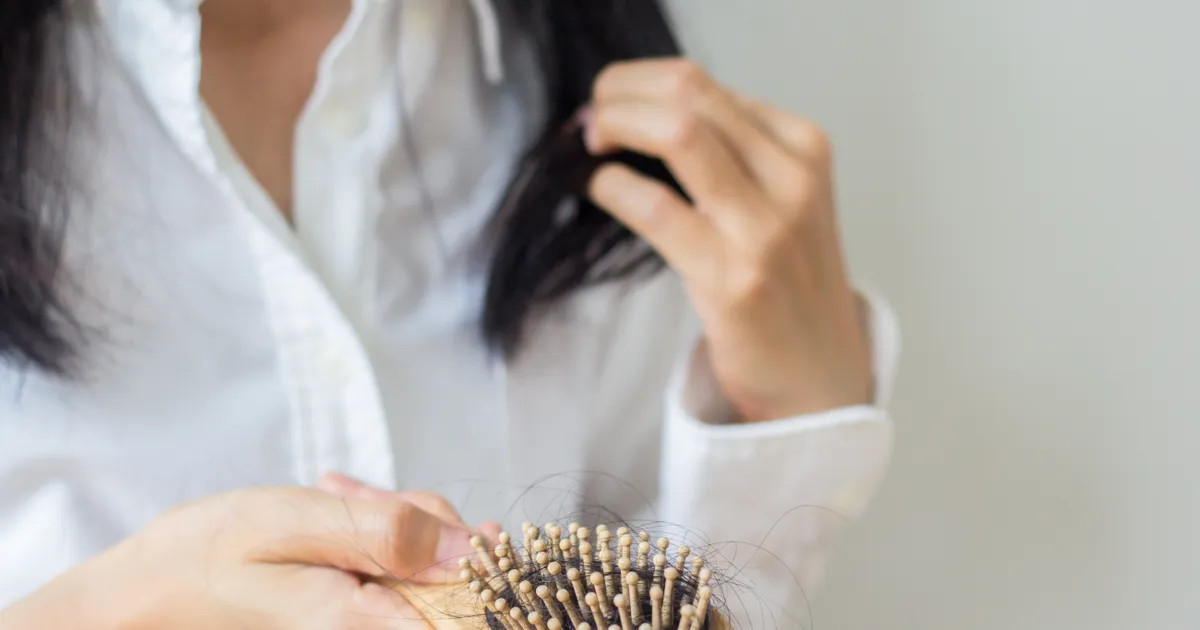It can undermine self-esteem, trigger emotional distress, and lead to a relentless search for remedies. Fortunately, you can learn everything you need to know about female hair loss with a search online right now.
Hair loss in women affects a significant number of females worldwide. Yet, understanding the nuances of female hair loss—its causes, symptoms, and the myriad of solutions available—can empower women to address this issue with confidence and clarity.
 Shutterstock: zentradyi3ell
Shutterstock: zentradyi3ellThe Root of the Problem: Causes of Female Hair Loss
Female hair loss can stem from various factors, often intertwined in complexity. Hormonal changes, particularly those associated with pregnancy, menopause, and thyroid disorders, are common culprits. Genetics also play a pivotal role, with female pattern hair loss (FPHL) being a hereditary condition affecting many.1
Stress, both physical and emotional, can precipitate temporary hair loss, known as telogen effluvium. Nutritional deficiencies, particularly in iron, vitamin D, and protein, can further exacerbate hair shedding. Lastly, certain hairstyles and treatments that apply tension or chemicals to the hair can lead to hair loss, a condition referred to as traction alopecia.
Recognizing the Signs: Symptoms of Female Hair Loss
Identifying hair loss early can lead to more effective management. Common symptoms include a widening part, noticeable thinning of the hair on the top of the head, and a visible scalp. Hair loss may also manifest as excessive hair shedding, where more hair than usual falls out during brushing or washing.
Unlike male pattern baldness, which often starts with a receding hairline, female hair loss typically maintains the hairline, with diffused thinning across the scalp. Clumps of hair falling out or bald patches are less common but can occur in certain conditions like alopecia areata.
Navigating Through Solutions: Treating Female Hair Loss
Medical Treatments
Several medical treatments have shown promise in managing female hair loss. Minoxidil, the only FDA-approved treatment for FPHL, can be applied topically to stimulate hair growth. For hormone-related hair loss, doctors may prescribe oral contraceptives or androgen receptor inhibitors such as spironolactone.2
In cases where hair loss is tied to an underlying health issue, addressing the root cause is crucial. For instance, supplementing iron for anemia or managing thyroid levels can significantly improve hair health.
Surgical Options
Hair transplant surgery, though less common for women, can be an option for those with stable hair loss patterns. This procedure involves moving hair from one part of the scalp to thinning areas, creating a more even hair distribution. However, it’s critical to consult with a specialist to assess suitability for this invasive treatment.
Alternative Therapies
The market is flush with alternative remedies, from essential oils to scalp massages, claimed to improve hair loss. While scientific evidence supporting these treatments varies, some individuals may find relief or improvement in hair texture and growth. It’s advisable to approach these remedies with caution and consult healthcare professionals when considering alternative therapies.
Lifestyle and Nutritional Adjustments
A balanced diet rich in vitamins, minerals, and protein can support hair health. Foods high in iron, vitamin D, and omega-3 fatty acids are particularly beneficial. Reducing stress through meditation, exercise, or therapy can also mitigate hair loss.
Additionally, adopting gentle hair care practices, avoiding tight hairstyles, and minimizing heat and chemical treatments can prevent further damage to the hair.
Empowerment Through Education: The Path Forward
Understanding female hair loss is the first step towards empowerment and effective management. Recognizing the signs early and seeking professional advice can open the door to a wide range of treatment options tailored to individual needs.
The journey to addressing hair loss is personal and varied, reflecting the unique nature of each woman’s experience. As research continues to evolve, new treatments and insights emerge, offering hope and solutions to those affected by this condition.
Staying Informed: The Role of Ongoing Research
The field of hair loss treatment is dynamic, with ongoing research unveiling new insights and therapies. Staying abreast of scientific developments can reveal emerging treatments that might offer hope and solutions previously considered out of reach.
For instance, recent advancements in platelet-rich plasma (PRP) therapy and low-level laser therapy (LLLT) have shown promise in stimulating hair growth for some women.3 Engaging with reputable sources and consulting healthcare professionals about new treatments can provide access to cutting-edge options that align with individual needs and preferences.
The Role of Professional Guidance
Consulting with dermatologists or trichologists specializing in hair loss is fundamental to devising an effective treatment plan. These professionals can offer diagnostic insights, recommend tailored treatments, and provide ongoing support throughout the treatment journey.
Furthermore, a mental health professional can be instrumental in navigating the emotional and psychological aspects of hair loss, offering strategies to cope with related stress and identity changes.
Find Help Today
Female hair loss, though challenging, is not insurmountable. With a comprehensive understanding of its causes, symptoms, and the treatments available, women can navigate this journey with knowledge and confidence. The key is to approach the condition with patience, seek support from medical professionals, and explore the solutions that resonate with personal health and lifestyle preferences.
Remember, the dialogue around female hair loss is growing, shedding light on this common yet underdiscussed issue. Continue to educate yourself, share experiences, and explore new developments in the field. Hair loss does not define you; with the right tools and information, you can take control and move forward with strength and optimism.
